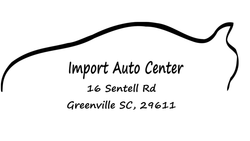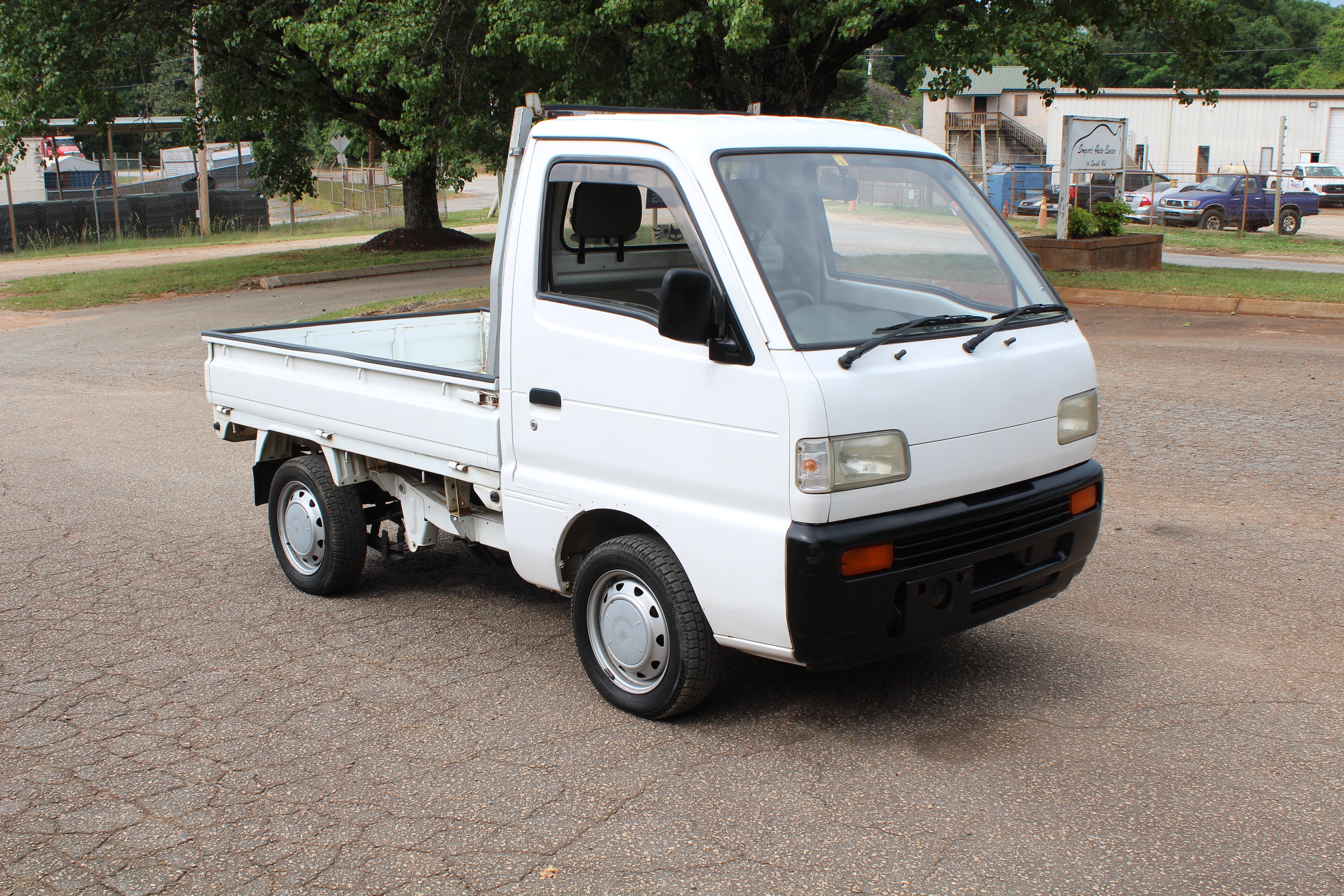Driven in Japan and here, imported. These keep going up in price and i cant hold on to them.
JDM Fed Legal White 1992 Suzuki Jimny Turbo 660cc 3 Cylinder 5 Speed 4 Wheel Drive(H/L) SUV, Weighs in under 1900lbs. Factory Rear LSD, Front Open Diff with Lockers. 4 Seater/Hard Top. 49,100 miles
The Japanese Jimny comes with 5.12 Final Drives, Rear LSD Differential, and a lower 4 low gearing then a Samurai. These things can crawl and make it through alot of places Jeeps cant cause its smaller and geared lower.
4 Stroke 3 Cylinder 660cc Liquid Cooled Fuel Injected engine. 49k Miles/79k kilometers Verified not rolled over.
This Jimny has some mods like a 2" Lift, Sway Bar Extensions, Aftermarket Wheels, Aftermarket catback Exhaust, Radio, Steering Wheel. It also has power steering(which is not common), A/C, Heat, Power Brakes.
Great For Offroading, I have one and it goes everywhere and anywhere. Super Fun Trucks and very similar to a Suzuki Samurai Just Lighter and Smaller Engines Turbo'd
Looks like the truck has been repainted, some repair on right fender and quarter, no rust underneath, front seats have some wear.
Fed Legal SC Title
Contact Rob 864-505-5621 for any questions, check out my Facebook page Import Auto Center for more pics and other JDM vehicles for sale.
Also my website: www.jdmimportautocenter.com
Not Interested in trades, thanks
The history of Suzuki four-wheel drive cars dates to 1968. Suzuki bought former Japanese automaker Hope Motor Company, which had introduced 15 small, off-road vehicles called the HopeStar ON360. The first Suzuki-branded four-wheel drive, the LJ10 (Light Jeep 10), was introduced in 1970. The LJ10 had a 359-cc, air-cooled, two-stroke, in-line two-cylinder engine. The liquid-cooled LJ20 was introduced in 1972 with the cooling changed due to newly enacted emission regulations, and it gained 3 hp. In 1975, Suzuki complemented the LJ20 with the LJ50, which had a larger 539-cc, two-stroke, in-line three-cylinder engine and bigger differentials. This was originally targeted at the Australian market, but more exports soon followed.[2]
The Jimny8/LJ80 was an updated version of the LJ50 with an 800-cc, four-stroke, in-line four-cylinder engine, followed by the Jimny 1000/SJ410 and Jimny 1300/SJ413. An updated version of the SJ413 became known as the Samurai and was the first Suzuki officially marketed in the US. The series from SJ410 to SJ413 was known as the Sierra in Australia, and remained the Jimny in some markets.
The new Jimny was released in 1998, and now bears the same name in all markets. The 1998 release used the G13BB EFI engine, replaced by the M13AA EFI engine in 2001 and the M13AA variable valve timing engine in 2005, in conjunction with a minor interior redesign.
Overall construction
All four Jimny generations have separate frame and body ("ladder frame chassis"). The body has no structural carrying role. It serves only as a cabin to protect the occupants from the elements, provide comfort and protect them in the case of a crash.
Suspension
All four Jimny generations have dependent suspension (solid / beam axles) both at the front axle and at the rear axle. This used to be a common suspension design for all terrain vehicles up to 1990s, but has become a rarity in vehicle design in the 21st century. Dependent suspension is particularly well suited for all terrain duty, both from the durability and performance perspectives.
First two Jimny generations used leaf-sprung suspension at all four wheels, with the 3rd and 4th generations using coil-sprung suspension at all four wheels. There is an exception where some late 2nd generation models had coil-sprung suspension as well (more info in dedicated sub-chapters).
Steering
All four Jimny generations have recirculating ball steering mechanism, which is particularly well suited for all terrain duty, but relatively imprecise on-road compared to modern rack-and-pinion steering construction.
Transmission
All four Jimny generations have manually user selectable part-time four wheel drive transmission, where the default (on-road) transmission mode is 2WD RWD (two wheel drive, rear wheel drive). Rear wheel drive can never be disengaged. The user however can (dis)engage the front wheel drive (FWD) manually at any time under certain operating conditions. When FWD is also engaged, this provides 4WD.
There is no center (inter-axle) differential. This has a positive effect that at least two wheels, where each wheel is on a different axle, have to lose traction in order for the vehicle to lose traction when in 4WD transmission mode. However, the negative effect is that 4WD transmission mode must not be used on any surface which is not rather slippery, especially if having to steer. In other words, 4WD transmission mode should be used only on rather slippery surfaces, like snow, ice, mud, loose gravel, wet grass and sand. Wet asphalt, wet concrete and hard-packed gravel are not considered slippery enough. All this is irrelevant when not using 4WD transmission mode.
All four Jimny generations have manually user selectable dual-ratio (dual range) gearing mechanism. The two ratios / ranges are called "high range" (for regular on-road driving and light to moderate all-terrain driving) and "low range" (for moderate to hard all-terrain driving and for all-terrain towing). The overall transmission gearing ratio is exactly halved when the vehicle is in low range transmission mode. This has the effect of the vehicle moving approximately twice as slow but with double torque at the wheels in any transmission gear. For example, the 4th gear in low range behaves similar to the 2nd gear in high range, and 3rd gear in low range behaves similarly as "1.5th gear" in high range. The transmission gearing range is selectable only when the vehicle is in 4WD transmission mode. Therefore, low range can not be used for on-road towing.
The (dis)engagement of 4WD transmission mode and the switch from one gearing range to another is performed by a dedicated transfer case mechanical unit, which is separate from the regular gear box unit. All four Jimny generations have a transfer case with an attached selection lever protruding in the cabin between the main gear box lever and the hand brake lever. The lever allows the user to select 2WD-H, 4WD-H or 4WD-L transmission modes at will. The only exception are later production years of 3rd generation Jimnys (more info in a dedicated chapter), which do not have a selection lever, but instead have servo-actuated mechanism which performs the same actions when invoked by the push of certain buttons in the cabin.
The JA71 was replaced in March 1990 by the new JA11 as new Kei category regulations took effect. Now with 657 cc on offer, the otherwise similar F6A engine only came with an intercooler and 55 PS (40 kW; 54 bhp). A utilitarian van (HA), as well as more luxurious Hardtop, Convertible, and Panoramic Roof (HC, CC, EC) versions were on offer.[33] The suspension was also upgraded, while a longer front bumper meant that the foglights could be mounted in front of the grille rather than in it. In June 1991, power was increased to 58 PS (43 kW; 57 bhp) and a year later power steering and automatic transmission became available for the first time. Top speed of this version was 120 km/h (75 mph).[16] In February 1995 power increased to 64 PS (47 kW; 63 bhp), but production of the JA11 ended only nine months later with the introduction of the coil spring JA12/22.
OVer 20 Years of Experience
South Carolina Dealership
Bonded & Insured
Drawer Title
- Choosing a selection results in a full page refresh.




































